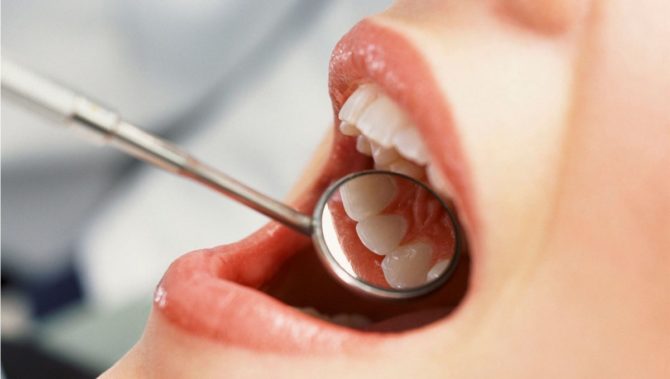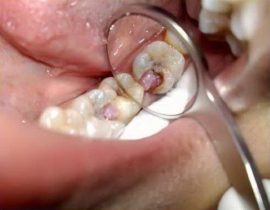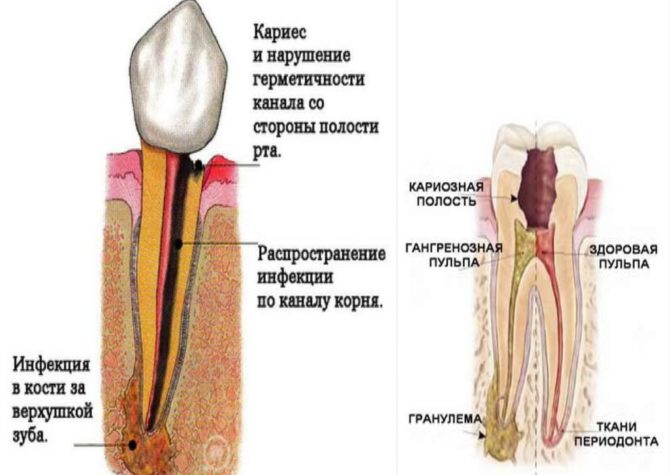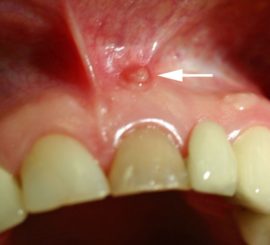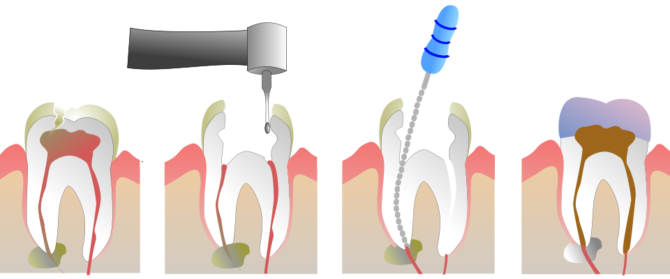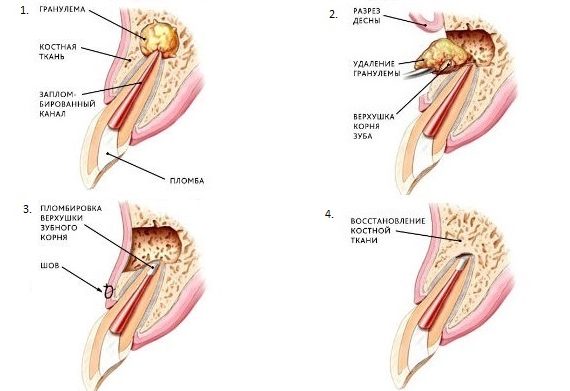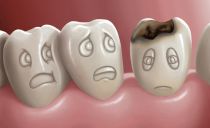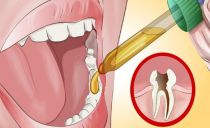What is a granuloma of a tooth root and how to cure it
With aching toothache or a small swelling of the gums, rarely anyone immediately turns to the dentist. All these symptoms seem completely harmless, although sometimes they pose a serious danger. A granuloma of the tooth could also become their cause, but not everyone knows what this disease is and how to cure it. Despite this, he must be treated with due attention, if treatment is started too late, the consequences can be most serious.
Content
- What is a tooth granuloma
- Symptoms of the development of granulomas of the tooth root
- Causes of tooth root granuloma
- What is dangerous granuloma of the tooth
- Drug treatment of tooth root granulomas at home
- Endodontic treatment of granuloma
- Surgical treatment of granuloma
- Recovery Recommendations
- The cost of treating a tooth granuloma
What is a tooth granuloma
Granuloma is an inflammatory process at the apex of the root of the tooth, characterized by the formation of blisters in the soft tissues. They are filled with liquid from dead cells, in which bacteria actively develop.
The people believe that a granuloma and a cyst are one and the same. In fact, these are inflammatory processes at different stages of development. Externally, the granuloma looks about the same as a cyst, but its size still does not exceed half a centimeter.
Even the most experienced specialist will not find granuloma at the initial stage without x-rays, especially if it is interroot. Therefore, it is recommended to visit the dentist at least twice a year and undergo a full examination.
Symptoms of the development of granulomas of the tooth root
The signs of a purulent bladder are easy to miss, since they also appear in other diseases. But if you find the following symptoms, you should definitely contact your dentist:
- Aching pain when chewing food on one side of the jaw.
- Unpleasant sensations when pressing on the tooth and gum around it.
- Swelling, redness of the mucous membrane.
- A slight increase in temperature over a long time.
- General malaise and weakness.
All the symptoms of tooth granulomas are inherent in a number of other dental diseases, but this does not mean that they should be ignored. You need to visit a specialist as soon as possible. Even if it turns out not to be a pouch, the doctor will be able to detect and cure another tooth problem in time.
Causes of tooth root granuloma
Sometimes a capsule with pus occurs in a patient, even if there were no prerequisites for this. But this happens infrequently, usually the following factors lead to the inflammatory process:
- Mistakes of a specialist in prosthetics and implantation. In this case, a granuloma of the tooth may occur under the crown.
- Damage to the tooth or soft tissue around it.
- Incorrect intracanal treatment.
- Complex tooth extraction.
- Chronic sinusitis and its exacerbation.
- Diseases like periodontitis, caries, or pulpitis.
- Retarded tooth growth.
Granuloma can occur even after professional tooth extraction, not to mention the more common factors. All the prerequisites are united by the fact that they lead to the penetration of the infection into the soft tissues, which is why granulation occurs.
What is dangerous granuloma of the tooth
The disease seems completely harmless, because it does not bring pain to the patient and most of the time does not manifest itself. The teeth look healthy. It is precisely this granuloma that is dangerous. It is extremely rare to detect a purulent capsule before it turns into a cyst with complications.
Granuloma can occur not only in the soft tissues of the tooth, but also on the gum.This happens when the bag of liquid is located too close to the outer wall or has already grown into a fistula. Such an abscess not only looks unpleasant, but also very dangerous.
In the treatment of fistula and cysts, therapeutic methods are no longer suitable, you have to resort to surgical intervention.
If granulation forms around the roots of a tooth, soon a person will simply lose it, and in the literal sense of the word. The infection will destroy all the connecting tissues between the tooth and the alveolar bone.
The infection itself has been kept in check for a long time by our immunity, but if he gives up his positions a little, the consequences will be more serious. Bacteria from the purulent bladder enter the bloodstream, which leads to inflammation of the soft tissues, tumors, sepsis, abscess, and phlegmon.
If such diseases are not treated, even a fatal outcome is possible. Therefore, you should not let the oral health to drift and treat tooth granulomas with folk remedies, especially since several conservative treatment methods are available to choose from.
Drug treatment of tooth root granulomas at home
The main difference between a granuloma and a cyst is that it can still be treated at home. Drug therapy for granuloma includes three groups of drugs:
- Antibiotics.
- Painkillers and anti-inflammatory drugs.
- Antiseptics.
The result of treating a tooth granuloma at home depends only on antibiotics, and everything else is an adjuvant. Of the available drugs, lincomycin is most often used. It is used in dentistry because of its high efficiency and low cost.
Sometimes the consequences of antibiotic treatment are more serious than the initial ailment, so probiotics are necessarily prescribed to the patient to restore microflora.
With the development of dental granulomas, patients experience general malaise, weakness and pain. To eliminate them, pain medications with an anti-inflammatory effect are prescribed, for example, Ketanov or Nimesil. Antiseptic agents are used to rinse the oral cavity. This item can be skipped if the disease was detected in the early stages.
Medication granuloma is treated for at least a month. Every week you should visit a specialist to track the results. If the inflammation does not decrease in size, other treatment methods are prescribed.
Endodontic treatment of granuloma
In this case, before treating a tooth granuloma, the contents of the bladder are removed. The tooth itself does not suffer, because the dentist gets to the abscess through the root canals, first clearing them and removing the pulp.
There are three methods of endodontic treatment:
- Standard removal using antiseptic agents.
- Depophoresis
- Transcanal laser dialysis.
In all cases, removal begins with an X-ray, as the specialist needs to find out exactly where the pus is. Then the damaged area is anesthetized, and the dentist cleans the root canal. The pulp cannot be saved: you have to completely remove it in order to get to the tumor.
Using a drill in the root canals creates free space. As soon as access appears, the purulent bag on the root of the tooth is punctured and cleaned of the contents. The further process depends on the method of therapy. In the first case, an antiseptic drug is poured into the cavity. Sometimes the patient is given a temporary filling, and the rest of the treatment is started when the infection is destroyed.
With depophoresis, copper-calcium hydroxide is poured into the formed void. The substance is exposed to an electric field. Particles move in a chaotic manner and penetrate even the most inaccessible areas of the purulent sac on the root of the tooth, removing all bacteria.
With the third method of treatment, the cavity is treated with a laser. It not only kills harmful organisms, but also promotes faster healing of tissues.With depophoresis and transcanal laser dialysis, the tooth is restored immediately after treatment: on the same day.
Surgical treatment of granuloma
Surgical treatment methods include the following operations:
- Cystectomy
- Hemisection.
They are prescribed for interroot granuloma, the development of cysts and fistulas, when other methods of treatment are already ineffective.
Cystectomy is the only operation in dentistry that gives one hundred percent result in granulation injuries of soft, bone and connective tissues. In other cases, the granuloma is not completely treated: there is a small chance that the infection will return. With cystectomy, this is impossible, because not only pus is removed, but also all damaged tissue.
The specialist exfoliates the gum flap and gets to the inflammation through the front wall of the jaw. Having access to the granuloma, the dentist first removes all the liquid from it. Then, using special tools, it removes elements of the mucous and bone tissue damaged by infection, and with them produces a resection of the root apex. The tooth itself does not suffer, because only a small part of it is removed.
Hemisection is one of the most difficult operations. It is prescribed only if pus on the root of the tooth is very difficult to reach. This usually happens when the molars are damaged.
During the operation, the dentist divides the tooth into two parts. The half near which the granuloma is located is removed. Then all the liquid is removed, and the damaged tissue is treated with an antiseptic. At the end, the gum is sutured so that it grasps the rest of the tooth. The saved half is used as a basis for restoration or hides under a crown.
Recovery Recommendations
After each type of treatment they give different recommendations, but several similar ones can be distinguished:
- Immediately after therapeutic and surgical treatment of tooth root granulomas, it is forbidden to eat and drink.
- Avoid temperature changes. Do not go to baths, saunas, do not stay in the cold for a long time.
- You can not touch the tooth, near which there was an abscess. Try to rule out any damage, especially after surgery.
- Regularly do baths with antiseptic drugs. To rinse the oral cavity in the usual way is possible only with medical treatment. In other cases, you need to be more careful.
- Do not resort to therapy in alternative ways. In this case, self-medication is extremely dangerous.
Do not forget about additional techniques from a specialist. Only with their help you can detect the re-development of the infection and take the necessary measures in time.
The cost of treating a tooth granuloma
Drug therapy is the most affordable way to cure granuloma on the root of the tooth. It costs patients only 3-5 thousand rubles for the entire period. Among other methods, both types of surgery are considered the cheapest. Cystectomy and hemisection usually do not cost more than 10 thousand rubles. In second place is depophoresis. Full treatment will take the patient 12-15 thousand rubles.
Transcanal laser dialysis is an effective but not the most common treatment. The point here is not even the price, but the fact that the technique is not available in all clinics. If the patient lives in Moscow or in another large city, the procedure will cost him 15-25 thousand rubles.
The costs do not end there. Tooth granuloma always requires antibiotic treatment for prophylaxis. Antiseptic agents are also an important part of therapy, therefore their price should be taken into account. Still need to allocate money for tooth restoration with transcanal and surgical treatment. The price depends on the type of seal or crown.
Granuloma is not the most dangerous disease of the oral cavity. The problem lies in its discovery. Therefore, be careful about the condition of your teeth and visit your dentist regularly.

